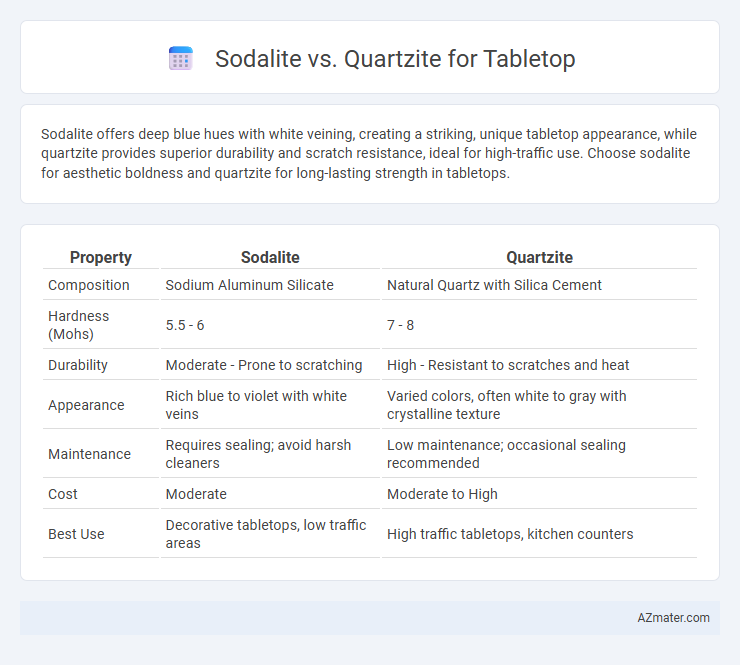Sodalite offers deep blue hues with white veining, creating a striking, unique tabletop appearance, while quartzite provides superior durability and scratch resistance, ideal for high-traffic use. Choose sodalite for aesthetic boldness and quartzite for long-lasting strength in tabletops.
Table of Comparison
| Property | Sodalite | Quartzite |
|---|---|---|
| Composition | Sodium Aluminum Silicate | Natural Quartz with Silica Cement |
| Hardness (Mohs) | 5.5 - 6 | 7 - 8 |
| Durability | Moderate - Prone to scratching | High - Resistant to scratches and heat |
| Appearance | Rich blue to violet with white veins | Varied colors, often white to gray with crystalline texture |
| Maintenance | Requires sealing; avoid harsh cleaners | Low maintenance; occasional sealing recommended |
| Cost | Moderate | Moderate to High |
| Best Use | Decorative tabletops, low traffic areas | High traffic tabletops, kitchen counters |
Introduction to Sodalite and Quartzite
Sodalite, a deep blue mineral rich in sodium and aluminum, is prized for its vibrant color and unique veining, making it a striking choice for tabletops. Quartzite, an ultra-hard metamorphic rock formed from sandstone, offers exceptional durability and a natural, often shimmering appearance, ideal for high-traffic surfaces. Both materials provide distinct aesthetic and functional benefits, with sodalite offering bold visual impact and quartzite delivering superior toughness and scratch resistance.
Physical Characteristics Comparison
Sodalite exhibits a deep blue color with white calcite veining, providing a striking and unique aesthetic, while quartzite offers a more consistent veining with colors ranging from white and gray to pink hues. Sodalite is relatively softer, measuring around 5.5 to 6 on the Mohs hardness scale, making it more prone to scratches, whereas quartzite rates between 7 and 8, offering superior durability and resistance to abrasion. Both stones have good heat resistance, but quartzite is less porous and more resistant to staining, making it a more practical choice for high-use tabletops.
Durability and Strength
Sodalite tabletops offer moderate durability with a Mohs hardness of around 5.5 to 6, making them more prone to scratches and chips compared to quartzite. Quartzite boasts exceptional strength and hardness ratings between 7 and 8 on the Mohs scale, ensuring superior resistance to impact, scratches, and heat. For tabletops requiring long-lasting durability and toughness, quartzite is the optimal choice over sodalite.
Color and Aesthetic Differences
Sodalite tabletops showcase deep blue hues with white veining, creating a bold and vibrant aesthetic that stands out in any space. Quartzite tabletops offer a more subtle, natural look with a range of colors from white and gray to soft browns, often featuring intricate veining that mimics marble. The rich, dramatic color palette of sodalite contrasts sharply with quartzite's neutral and earthy tones, making sodalite ideal for statement pieces and quartzite better suited for versatile, classic designs.
Maintenance and Care Requirements
Sodalite tabletops require gentle cleaning with mild soap and water to prevent damage, as the stone is relatively soft and prone to scratches and etching. Quartzite tabletops, known for their hardness and durability, resist scratches and heat but still need sealing periodically to maintain stain resistance and facilitate easier cleaning. Both materials benefit from avoiding harsh chemicals and abrasive tools to preserve their aesthetic appeal and longevity.
Resistance to Heat and Staining
Sodalite offers moderate resistance to heat but is more prone to staining due to its porous nature, requiring regular sealing to maintain its appearance. Quartzite excels in heat resistance and is less likely to stain, making it a durable choice for tabletops exposed to high temperatures and frequent spills. Homeowners seeking long-term durability and low maintenance often prefer quartzite for its superior resistance to both heat and staining.
Cost and Affordability
Sodalite tabletops typically range from $70 to $120 per square foot, making them a more affordable option compared to quartzite, which averages between $100 and $150 per square foot. Quartzite's higher cost reflects its superior hardness and resistance to scratches and heat, ensuring long-term durability in high-use environments. For budget-conscious buyers seeking a visually striking tabletop without sacrificing too much durability, sodalite offers a cost-effective, aesthetically rich alternative.
Installation Considerations
Sodalite tabletops require careful handling due to their relative softness and susceptibility to scratching compared to quartzite, which is harder and more durable. Installation of sodalite involves using specialized adhesives and sealants to prevent staining and minimize damage from moisture exposure, whereas quartzite's natural resistance reduces the need for extensive protective treatments. Both materials demand professional installation to ensure secure fitting and long-term stability, but quartzite typically allows for easier maintenance and resilience under heavy use.
Best Use Cases for Each Material
Sodalite, known for its deep blue hues and striking white veins, is best suited for decorative tabletops in low-traffic areas where aesthetic appeal is prioritized over durability. Quartzite offers superior hardness and scratch resistance, making it ideal for kitchen countertops and dining tables subjected to heavy daily use. Choosing quartzite for functional surfaces ensures longevity, while sodalite enhances visual impact in more controlled environments.
Conclusion: Which is Better for Your Tabletop?
Sodalite offers striking deep blue hues with white veining, making it an eye-catching choice for tabletops, while quartzite provides exceptional durability and resistance to scratches and heat, ideal for heavy-use areas. Quartzite's hardness and low porosity ensure long-lasting performance with minimal maintenance compared to sodalite, which is softer and more prone to damage. For a balance of aesthetic appeal and practical durability, quartzite is generally the better option for everyday tabletops.

Infographic: Sodalite vs Quartzite for Tabletop
 azmater.com
azmater.com